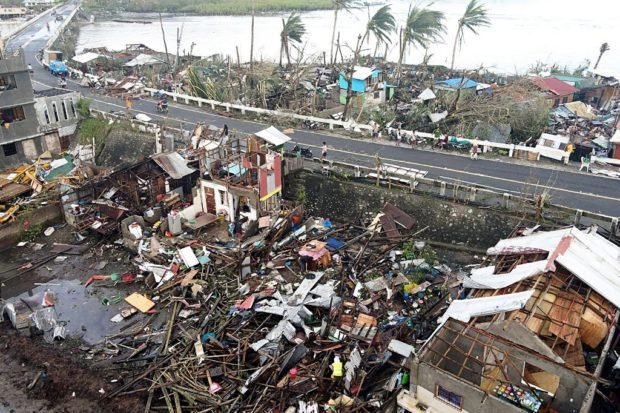
As the saying goes, many don’t concern themselves with an issue until it directly affects them. Strangely, I, too, find myself guilty of that narrative.
I live in Dumaguete City. The last time a major typhoon devastated my area was when Tropical Storm “Sendong” (international name: Washi) hit in 2011, and I was only 4 years old.
Back then, I stayed at my grandparents’ home, which has several acacia trees and a large lawn. I remember being overjoyed when preschool classes were cancelled for the day, and fairly upset when the house help didn’t allow me to ride my bike like I always did in the late afternoons.
“There’s a typhoon,” my yaya, Ate Leah, said, ushering me and my 3-year-old brother back inside. Unlike me, he was happy to return to building his Lego airplane. So, with nothing else to do, I pressed my nose on the fogged-up window. The clear skies and the familiar chirps of maya birds were long gone, clouds of stormy gray rolled over the horizon.
I had since long forgotten what it felt like to hear news of buildings submerged in water, roofs torn off houses and the hopelessness of being at that young age, in which you are not able to do anything about it.
That was until last week.
Sleepless night
I was at the dinner table with my brother and sister, now nearly teenagers, the dull, quiet air of spending months indoors choking the wordless atmosphere between us. Our gadgets beeped in unison, signaling notifications pointing toward what would be the strongest typhoon of the year—“Odette” (international name: Rai). We charged our devices, brought our pets indoors, prepared flashlights and battery-powered fans, while my father set up the power generator. It was going to be a long night.
I didn’t get much rest that night. But the sleepless night, worry, and the steady pounding of rain on our roof were a lot better than what other people in the rest of Negros, Cebu, Bohol, Surigao and northeastern Mindanao areas were experiencing.
The winds and squalls toppled major electric lines, causing widespread power outages across the region and a quickly dwindling water supply.
The typhoon landed on the island of Surigao Dec. 16. With no major landmass nearby except for Bohol, by the time the typhoon hit Cebu that night, its winds were still moving at a steady 175 kilometers per hour. At its peak, “Odette” reached maximum sustained winds of 195 km/h. Signal No. 4 was the highest tropical cyclone wind signal raised during the onslaught of the typhoon.
Sadly, few typhoons come without fatalities, and “Odette” was not one of them. According to various local disaster management facilities, Cebu City reported 13 dead, Mandaue City had seven and Mactan island, six. There were 13 in Negros Occidental, six in Negros Oriental, three in Southern Leyte, one in Samar, two in Iloilo, two in Guimaras and one in Bohol.
After wreaking its havoc on the region, “Odette” slightly intensified over the West Philippine Sea ahead of its exit from the Philippine Area of Responsibility.
Devastating
The silence after a typhoon is always the worst. You wait for updates, but all you get is eerie quiet and the smell of petrichor and rain on the ravaged earth. Some say not knowing at all is better than harboring knowledge that only brings grief. When we finally got our Wi-Fi connection back, I went online to see devastating photos and videos of a flooded Cagayan de Oro, shattered slums in Surigao, and the caught-on-camera aftermath of the onslaught of “Odette.” Nothing struck more than the knowledge that it would only happen again—and with the same casualties if we do not call ourselves to action. “These typhoons have and will continue to be a constant reality to Filipinos,” says Kids for Kids PH, a youth-led organization for culture, climate and children’s rights. “If adapting to the crisis isn’t at the top of our agenda, we are failing our people at all aspects of life.”
Resiliency is an admirable virtue of Filipinos in times of crisis, but it should not be normalized. Instead of spreading its ideals for little more than media novelty and press coverage, we should rather shift our focus on the needed disaster preparedness, spreading awareness and calls for help, and relief for its victims and affected areas, so that the next time a typhoon like “Odette” hits, we will be ready.
How to help
Inquirer joins the nation in support of the people affected by Typhoon “Odette” and supports efforts to send them immediate aid. Cash donations may be deposited in the Inquirer Foundation Corp.’s Banco de Oro (BDO) account no 007960018860 or through PayMaya.
But help doesn’t end there. Offer assistance to the people around you. Check on your neighbors, friends, relatives, and anyone who might be at the risk of succumbing to the typhoon’s hazards. Clear sidewalks, and call authorities to handle low-hanging wires and fallen electricity posts.
Many local sectors are stepping up to provide aid for the people affected. Consider donating food, water, clothes and essentials to evacuation centers and donation channels. In times of crisis, unity is needed now more than ever.
The following sunny afternoon, I found it seemingly unpleasant for the sun to shine so brightly on a day when so many homes were ruined, streets were flooded and lives were lost. But like it will always rise at dawn, even after the darkest of nights, we go through our lives not with the surety of a tomorrow, but with the knowledge that whatever happens, it is a new day to rebuild, and offer our relief, donations and prayers to the people who need it the most.













































